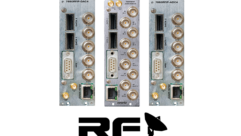GROUND RODS: magic noise sinks?
Nov 1, 2000 12:00 PM,
Bill Whitlock
Earth ground rods seem to have acquired a magical reputation for reducing or eliminating noise in audio and video systems. In this column, I will briefly explain the actual purpose of earth grounding and deal with some of the myth and misinformation about it. In electrical and electronic systems, there are two basic kinds of grounds, safety grounds and signal grounds, which each serve two entirely different purposes.
Grounding for safetyEarth grounding at the entry point for utility AC power serves two main purposes. First, it provides a direct path to earth should lightning strike the power line. It is important to prevent lightning from finding its way inside a building, where it might kill someone or start a fire. Second, it connects the building’s safety ground wiring to earth ground. This prevents dangerous voltages from developing between grounded appliances, such as washing machines, and other metal objects that people might contact, such as appliances or fixtures grounded to earth via connections to water or gas pipes.
Although the safety ground wiring is connected to earth ground at the main panel, it is important to understand that the protection from defective appliances or equipment provided by the grounding prong on power plugs does not need an earth ground to perform its main function. As shown in Figure 1, when such a defect as insulation breakdown occurs in equipment, a fault current flows from the hot (black) wire of the power line, through the equipment short to its chassis, and back through the safety ground (green) wire to the breaker box where safety ground and neutral (white) are connected. Because this path consists of heavy gauge wiring (required by code), its impedance is low. This causes a high fault current, quickly tripping the circuit breaker. The impedance of the safety ground (green) wiring is also low enough to ensure that no dangerous voltage ever develops across its length. Even during the brief time it takes to trip the breaker, well under 30 V would typically exist between the chassis of the defective equipment and any other ground. That is why maintaining the connection to the third prong is necessary to prevent shock, electrocution or fire.
Now look at Figure 2, which is the same scenario but with the equipment chassis grounded to another, separate ground rod instead of the power system safety ground (green) wire. The soil resistance between two ground rods, even if they are located only a few feet apart, can be as high as 10 V to 20 V. This will limit the fault current to less than 12 amperes, which is not nearly enough to trip a typical 15 ampere or 20 ampere circuit breaker, no matter how long the fault current flows. This means that most of the line voltage would exist between the ground rods themselves, simply heating the soil. It also means that the chassis of the defective equipment would still be at nearly full line voltage relative to any other ground (such as other equipment or a water pipe). The equipment chassis would remain a shock or electrocution hazard. If the defective equipment were connected via a signal cable to other properly grounded equipment, it is also likely that the fault current would flow in the shield of that cable, causing it to melt down or start a fire.
The point is that separate earth ground rods can never serve as a substitute for the safety ground provided at electric outlets. At a recent CEDIA show, I attended a class whose topic, eliminating noise in A-V systems, caught my attention. The instructor was sales director for a power-conditioning equipment maker. His spins on the reality of physics made me cringe, but they were relatively harmless, endangering only wallets. I had to protest out loud (seconded by a licensed electrician who was also in the class) when he suggested reducing system noise by grounding equipment to a separate ground rod rather than the noisy safety ground at the outlet. As you can see from Figure 2, this practice is not only extremely dangerous, but it also violates National Electrical Code. At the same show I attended a truly excellent class on National Electrical Code taught by master electrician and college instructor Ken Erdmann. It was the contrast between these two classes which inspired this column.
Signal groundingSignal grounds do not require connections to earth. They are simply reference points for electronic signals. I like the excellent definition by Henry Ott, distinguished member of the Bell Laboratories technical staff: “Signal ground is a low-impedance path for current to return to the source” (Ref 1). For example, consider the electronic systems in an aircraft, which can, with a properly designed grounding system, be noise-free. As a practical matter in earth-bound systems, however, safety grounds and signal grounds are usually connected together at some point.
In reality, most of the reports of fantastic noise reduction attributed to earth ground rods are actually the result of the separation of various ground wires and their connection to a single point. It is the separation of the ground current paths that eliminates the common-impedance coupling of noise from noisy equipment into quiet equipment. It is extremely rare for an additional earth ground connection to solve a noise problem.
Because small leakage or stray currents always flow in safety ground wiring of AC-powered equipment, there will always be small voltage differences between any two ground points in the system. This fact of life can cause system noise problems because ground loops are formed by signal cables that connect system components. These small voltages can couple into the signal paths, thereby adding considerable noise to audio and video systems and errors or crashes to digital systems. This is especially true for such unbalanced interconnections as RCA audio, coaxial video or RS-232 data. As I have pointed out in previous columns, there are safe and effective methods to eliminate the ground loops that do not endanger your clients’ lives or property.
Have you ever noticed how rarely you find the Underwriters Laboratories “UL Approved” label on high-end audiophile or professional audio equipment? One reason is that some of this gear, especially exotic power conditioners and power strips, is truly dangerous because it either disconnects safety ground or has a switch that allows an unwary user to do so. I think it is truly outrageous that a portion of our industry engages in this commerce without conscience.










